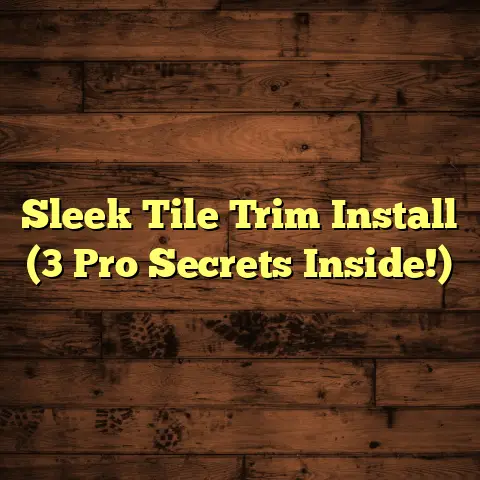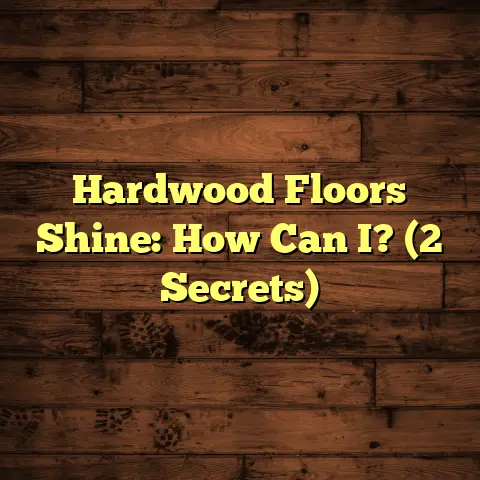Shine Dull Hardwood (5 Pro Secrets!)
In today’s world, where aesthetics matter more than ever, having floors that shine is a game-changer. Let’s dive into how you can achieve that dazzling look with my top 5 pro secrets!
Section 1: Understanding the Importance of
Shine in Hardwood Flooring
Let’s be real, a dull hardwood floor is a downer. It makes the whole room feel…blah. But a shiny floor? That’s a different story!
Visual Impact:
Think about it: A shiny floor reflects light, making the room feel brighter and more spacious. It highlights the natural grain and color variations in the wood, adding depth and character.
Dull floors, on the other hand, absorb light, making the room feel darker and smaller. They also tend to hide the wood’s natural beauty.
Cleanliness, Warmth, and Luxury:
A shiny floor instantly gives the impression of cleanliness. It’s like saying, “Hey, I take pride in my home!” Plus, the warmth of the wood combined with the shine creates a welcoming, luxurious vibe.
I’ve seen countless homes transformed simply by restoring the shine to their hardwood floors. It’s amazing what a difference it makes!
Maintenance is Key:
Maintaining that shine isn’t just about the initial cleaning or refinishing. It’s about consistent care. Think of it like brushing your teeth; you can’t just do it once and expect a lifetime of pearly whites.
Regular maintenance is crucial for preserving the beauty and longevity of your hardwood floors. We’ll get into the specifics later, but remember: prevention is always better (and cheaper!) than cure.
Section 2: Assessing Your Hardwood Floor’s
Condition
Before you start slathering on polish, take a good, hard look at your floors. What’s the real situation?
Signs of Dullness:
-
Scratches: These are the most common culprits. Even tiny scratches can dull the overall shine.
-
Stains: Water stains, pet stains, and food spills can penetrate the finish and leave unsightly marks.
-
Discoloration: Over time, sunlight can cause certain areas of your floor to fade or change color.
-
Cloudiness: This is often caused by a buildup of cleaning products or waxes.
-
Lack of Reflection: If your floor doesn’t reflect light like it used to, it’s a sure sign of dullness.
Homeowner’s Checklist:
Grab a notepad and pen, and let’s get to work.
-
Overall Appearance: Stand back and take in the whole floor. Does it look uniformly dull, or are there specific areas that are worse than others?
-
Scratch Test: Get down on your hands and knees and look closely for scratches. Use a flashlight to highlight any imperfections.
-
Stain Check: Identify any stains and try to determine their source. This will help you choose the right cleaning products.
-
Finish Condition: Is the finish worn away in high-traffic areas? Are there any signs of peeling or cracking?
-
Moisture Levels: Check for signs of water damage, such as cupping or buckling. These issues need to be addressed before you can restore the shine.
Industry Insights: According to the National Wood Flooring Association (NWFA), proper assessment is the first step in any successful hardwood floor restoration project. Getting it wrong can lead to more problems down the line.
Section 3: Pro Secret #1: Deep Cleaning Techniques
Alright, you’ve assessed your floor and you’re ready to get cleaning. But not just any cleaning will do. We’re talking DEEP cleaning!
Effective Cleaning Methods:
-
Vacuuming: This is your first line of defense. Use a vacuum with a soft brush attachment to remove dirt, dust, and debris. Avoid using a beater bar, as it can scratch the finish.
-
Dust Mopping: Use a microfiber dust mop to pick up any remaining particles. These mops are great because they trap dirt instead of just pushing it around.
-
Hardwood Floor Cleaner: Choose a cleaner that’s specifically designed for hardwood floors. Avoid using harsh chemicals, abrasive cleaners, or vinegar, as these can damage the finish.
Choosing the Right Products:
I can’t stress this enough: always read the label! Make sure the product is pH-neutral and won’t leave a residue. I’ve seen too many floors ruined by people using the wrong cleaners.
Here’s a quick rundown of what to avoid:
-
Ammonia-based cleaners: These can strip the finish.
-
Oil-based soaps: These can leave a sticky residue.
-
Vinegar: While it’s a popular natural cleaner, it can dull the finish over time.
Step-by-Step Deep Cleaning Guide:
-
Vacuum or dust mop: Remove all loose dirt and debris.
-
Prepare your cleaning solution: Follow the instructions on the cleaner label.
-
Damp mop: Use a microfiber mop and wring it out thoroughly. The mop should be damp, not wet.
-
Work in sections: Clean small areas at a time, overlapping each stroke.
-
Dry immediately: Use a clean, dry microfiber cloth to wipe up any excess moisture.
-
Repeat if necessary: For heavily soiled areas, you may need to repeat the process.
Pro Tip: Always test the cleaner in an inconspicuous area first to make sure it doesn’t damage the finish.
Section 4: Pro Secret #2: Refinishing vs. Recoating
Okay, so you’ve cleaned your floors, but they’re still not as shiny as you’d like. It might be time to consider refinishing or recoating. But what’s the difference?
Refinishing:
This involves sanding down the existing finish to bare wood and applying a new finish. It’s a more intensive process, but it can completely transform your floors.
Recoating:
This involves applying a fresh coat of finish over the existing finish. It’s a less invasive process that can restore the shine without completely re-doing the floors.
Which Method is Right for You?
-
Refinish if:
- Your floors have deep scratches or gouges.
- The finish is worn away in high-traffic areas.
- You want to change the color of your floors.
-
Recoat if:
- Your floors have minor scratches or scuffs.
- The finish is dull but still intact.
- You’re happy with the current color of your floors.
The Refinishing Process:
-
Preparation: Remove all furniture and cover any areas you don’t want to get dusty.
-
Sanding: Use a drum sander to remove the old finish. Start with a coarse grit sandpaper and gradually move to finer grits.
-
Vacuuming: Thoroughly vacuum the entire floor to remove all sanding dust.
-
Staining (optional): If you want to change the color of your floors, apply a stain according to the manufacturer’s instructions.
-
Finishing: Apply several coats of finish, allowing each coat to dry completely before applying the next.
The Recoating Process:
-
Preparation: Clean the floors thoroughly to remove all dirt and debris.
-
Screening: Use a floor buffer with a screening pad to lightly abrade the existing finish. This will help the new finish adhere properly.
-
Vacuuming: Thoroughly vacuum the entire floor to remove all screening dust.
-
Finishing: Apply a coat of finish, allowing it to dry completely.
Pro Tip: Refinishing is a messy and time-consuming process. If you’re not comfortable doing it yourself, hire a professional.
Section 5: Pro Secret #3: The Right Finish for a
Lasting Shine
The finish you choose can make or break the shine and durability of your hardwood floors. Let’s explore the options.
Types of Finishes:
-
Oil-Based Polyurethane: This is a classic choice that provides a durable, long-lasting finish. It has a warm, amber tone and is resistant to scratches and water damage.
-
Water-Based Polyurethane: This is a more eco-friendly option that dries quickly and has a clear, non-yellowing finish. It’s also low in VOCs.
-
Moisture-Cured Urethane: This is the most durable finish available, but it’s also the most difficult to apply. It’s typically used in commercial settings.
-
Penetrating Oil: This type of finish penetrates the wood and hardens from within. It provides a natural look and feel, but it’s not as durable as polyurethane.
Impact on Shine and Durability:
Oil-based finishes tend to have a higher sheen than water-based finishes. However, water-based finishes are more resistant to scratches and UV damage.
The durability of the finish depends on the number of coats applied and the quality of the product. I always recommend applying at least three coats for optimal protection.
Choosing the Right Finish:
Consider these factors when selecting a finish:
-
Lifestyle: If you have kids or pets, you’ll need a more durable finish.
-
Usage: High-traffic areas require a more resistant finish.
-
Aesthetic: Do you prefer a warm, amber tone or a clear, non-yellowing finish?
Industry Data: According to a study by the Forest Products Laboratory, oil-based polyurethane provides the best overall protection against wear and tear, while water-based polyurethane is the most environmentally friendly option.
Section 6: Pro Secret #4: Regular Maintenance Routines
Alright, you’ve got your floors shining. Now, how do you keep them that way? Consistency is key!
Maintenance Schedule:
-
Daily: Sweep or vacuum to remove dirt and debris.
-
Weekly: Damp mop with a hardwood floor cleaner.
-
Monthly: Inspect for scratches, stains, and other damage.
-
Annually: Consider recoating to refresh the finish.
Preventing Dirt Buildup and Scratches:
-
Use doormats: Place doormats at all entrances to trap dirt and debris.
-
Remove shoes: Encourage family members and guests to remove their shoes before entering the house.
-
Trim pet nails: Keep your pet’s nails trimmed to prevent scratches.
-
Use furniture pads: Place felt pads under all furniture legs to protect the floor from scratches.
Daily, Weekly, and Monthly Practices:
-
Daily: A quick sweep or vacuum can prevent dirt from accumulating and scratching the finish.
-
Weekly: Damp mopping with a hardwood floor cleaner will remove any remaining dirt and grime.
-
Monthly: A thorough inspection will help you identify any potential problems before they become major issues.
Personal Story: I once had a client who neglected their hardwood floors for years. By the time they called me, the floors were so damaged that they needed to be completely replaced. Don’t let that happen to you!
Section 7: Pro Secret #5: Utilizing Professional Services
Sometimes, DIY just isn’t enough. That’s where professional flooring services come in.
Benefits of Hiring Professionals:
-
Expertise: Professionals have the knowledge and experience to properly assess and restore your hardwood floors.
-
Equipment: Professionals have access to specialized equipment that can make the job easier and more efficient.
-
Warranty: Many professionals offer warranties on their work, giving you peace of mind.
What to Look for in a Flooring Professional:
-
Certifications: Look for professionals who are certified by the NWFA.
-
Experience: Choose a professional with a proven track record of successful hardwood floor restorations.
-
Insurance: Make sure the professional is insured in case of accidents or damage.
Testimonials and Case Studies:
I’ve helped countless homeowners restore their hardwood floors to their former glory. Here’s what one of my clients had to say:
“I was amazed at the transformation of my hardwood floors. They looked dull and worn before, but now they look brand new!
Case Study:
A homeowner in Chicago had hardwood floors that were covered in scratches and stains. They hired me to refinish the floors and apply a new coat of finish. After sanding, staining, and applying three coats of oil-based polyurethane, the floors looked stunning. The homeowner was thrilled with the results.
Real-World Statistics: According to a survey by HomeAdvisor, the average cost of refinishing hardwood floors is \$3 to \$8 per square foot. While it may seem like a significant investment, it’s often more cost-effective than replacing the floors altogether.
Conclusion: The Lasting Impact of Shiny Hardwood Floors
So there you have it – my top 5 pro secrets for bringing back the luster to your dull hardwood floors. Remember, maintaining the beauty of your hardwood flooring is an investment that pays off in the long run.
Key Takeaways:
-
Shine is essential for creating a welcoming, luxurious space.
-
Proper assessment is the first step in any restoration project.
-
Deep cleaning is crucial for removing dirt and grime.
-
Refinishing and recoating can restore the shine to worn floors.
-
Choosing the right finish is essential for durability and aesthetics.
-
Regular maintenance is key to preserving the beauty of your floors.
-
Professional services can provide expertise and peace of mind.
By implementing these secrets, you can enjoy the beauty and warmth of your hardwood floors for years to come. So go ahead, take proactive steps and transform your home today!





